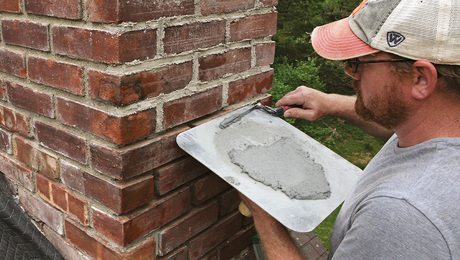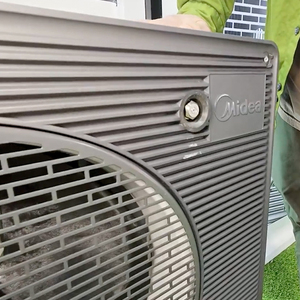Attaching furring strips to brick wall
What is a good way to attach furring strips to a brick wall so that I can hang drywall on it? Is there a better way than using Tapcon screws? If I use Tapcon screws, what size should I use (3/16″ or 1/4″) and how far apart should I space the screws on a furring strip (12″, 16″, something else)? Should I drill the holes through the brick rather than through the mortar joints? I’m also planning on using Liquid Nails on the back of the furring strips in addition to the Tapcon screws.
Is there a good reference source for showing these details?
Thanks!



















Replies
Run a continuous bead of PL adhesive on the back of the strips ... use three tapcons to hold the strip until the PL sets ... overnight would work ... put the tapcons into the brick.
Whenever you are asked if you can do a job, tell'em "Certainly, I can!" Then get busy and find out how to do it. T. Roosevelt
Thanks. Is PL adhesive much better than Liquid Nails? I've always used Liquid Nails. I looked at their website. Are you talking about their PL 200 Construction Adhesive? I need to buy a hammer drill to drill into the brick. I don't need a rotary hammer to drill into the brick, do I?
the PL is cool , but i'd drill into the mortar joints.. you'll drive yourself crazy drilling the brick... for what ?
also... all you're doing is hanging drywall.. i'd ramset the furring ( into the mortar joints) with a small load
Mike Smith Rhode Island : Design / Build / Repair / Restore
Edited 7/21/2004 11:02 am ET by Mike Smith
Use the bit that comes with tapcons, 3/16" I think. Drill thru furring strip and brick about 2" deep. Cut a piece of tie wire ( the stuff you tie rebar with) about 2" long and place in hole. Drive a 16d short ( simpson joist nails) and the furring strip will never come out. The nail wedges against the wire. I use this method instead of tapcons, usually with regular 16d nails. I also use vinyl covered wired although regular tie wire works just as good. If you have to shim the furring do not nail the strips home. Shim, then nail it home.A hammer drill will work but a small roto-hammer is best. Takes about two or three seconds at most to drill brick or concrete with roto-hammer.Nail top bottom and space out two in the middle.Drill into brick not mortar joint.
mike
Edited 7/21/2004 3:22 pm ET by MIKEK4244
Mike,
Thanks for providing me with the most details I've seen anywhere so far on this topic. Does the 2" deep hole you mention include the 3/4" thickness of the furring strip, so I'd only be drilling about 1-1/4" inches into the brick? I think I'd get more use out of a hammer drill than a rotary hammer in doing other projects around the house even though a rotary hammer would be better suited in this application, so how long would it take to drill a hole with a hammer drill versus a rotary hammer? I'm not real fast in completing projects (and I like to collect [and use] tools), so I think renting wouldn't work for me. I used my 12V Porter-Cable cordless drill once a while back to drill holes for Tapcons in solid masonry foundation walls and that was painfully slow. How much faster is a hammer drill?
Good advice,but I will frame the wall with 1"x2" metal studs. This way you have the room for insulation 3/4 (styrofoam) and you only loose 1".
Prefab the metal framing and use foam between the studs and brick.
YCF Dino
Buy a hammer drill. Hammer drills are far subservient to roto-hammers, but for your use it will be sufficient. Your hammer drill can also drill into wood, steel, etc. which a roto cannot do. It won't take long at all for the small diameter holes you will need.
Jon Blakemore
Why won't a roto drill into other things such as wood? I have had no problems with my Bosch.Les Barrett Quality Construction
Honestly I don't know. The rotation speed is very low, so I would think that you would only want to drill large holes with it. Do you use a roto hammer for wood?
Jon Blakemore
I normally use a drill appropriate to the job, but never hesitate to use the roto if I already have it out. I use it for steel beams, concrete, concrete chipping (such as beam pocket adjustment), TSL, and anywhere I have to go through multiple materials to get to concrete. It works for most applications like a hot knife through butter. The key, as was brought out in FHB, is to let the tool do the work. This saves $$bits$$.Les Barrett Quality Construction
Yes it does include the furring strip. 1 1/4" of nail should be plenty of nail into the brick. If the nails do not hold use a 16d nail ( 3 1/2" ).A hammer drill will do the job , rotohammer will do it faster. I use a small Bosch roto hammer that drills up to 5/8" .Comes in handy for post anchors and such. I looked up hammer drills and roto hammers on the web, Dewalt hammer drill $169.00 ;Dewalt roto hammer that drills up to 1 " in concrete $179.00. Not much difference in cost for a more versatile (IMOP) machine.Hammer drill in brick should take about 30 seconds to drill 2" hole with a 3/16" masonary bit. These bits wear out quickly and are more prone to breaking. They go into a chuck like a electric drill. Roto hammer bits are completely different, they have a splined shaft that slides and locks in a collet type of chuck. Bits last much longer. Even though the rotohammer bits cost more initially, they are much more cost efficient. Should take no more than 3 or 4 seconds to drill thru furring strip and brick.
As the names imply, hammer drills beat very fast but not very hard. Rotohammer bangs hard and turns slowly.I prefer a rotohammer for your application, hammer drill will work , just not as easily.Neanderthal way when I was a kid was a star drill and a 3lb hammer, also did the job and get large forearms as an added bonus.
mike
Agree with PL400 and ramset / Hilti gun in. Quick and easy. I'd also throw out the idea of looking into Z channel - like metal studs, and it does require your wall to be pretty even planed, but the combo of Z channel and EPS insulation is a good one in a basement, and consumes a minimum of floor space.
"If you pick up a starving dog and make him prosperous, he will not bite you. This is the principal difference between a dog and a man." - Mark Twain
Go with Dino. Using metal studs allows room for insulation and places to run wires. Plus the wall wil be nice and straight . No need to fuss with masonary anchors or glue failure. I helped a friend of mine fur out his walls in a 19th century victorian, what a huge PITA. Had we known any better we would have used steel. Much cheaper and faster. Did I mention how much cheaper and faster I think it would be?
J.P.
I agree with Dino's approach. It's great to have the solid foam insulation barrier and the straight steel walls. Second choice would be the Z-bars and foam, with steel in front.
Have you checked your brick walls to see if they are straight and plumb?
Billy
Thanks for all the helpful advice. The brick wall I want to drywall over is in my family room and it has a fireplace in the middle of it and it also has a raised brick hearth running the entire length of the wall. I'm going to add a tile surround to the fireplace and tile the raised hearth and drywall the rest of the wall and add a mantel around the surround. I don't think I need to go with metal studs in this case.
How old is your brick? If this is 100+ year old soft brick, you may have trouble using the above techniques to mechanically hold the furring to the wall. My experience with old brick is that it will often disintegrate if you try to wedge a fastener into it and I end up drilling a large hole and using either an lead or zinc anchor or epoxying wood into large holes and screwing into them. Fairly labor intensive but I end up with better peace of mind.
The brick is "used" brick in a 25 year old house. The brick is very hard. I've already knocked off some high spots on the hearth using a cold chisel and 3 lb mallet in preparation for tiling it and it takes some effort to knock off some small chips.
If you can use furring strips you can use metal studs(.1x2 metal studs)
You can even use the metal studs sideways and save more space.
Use aluminum L shaped trim from Home Depot instead of top and bottom runners.
Prefab the sections and use foam to glue the metal to the brick. 12'' OC .
Edited 7/22/2004 7:11 pm ET by YCFriend
A single-shot, hammer-fired Remington powder-actuated tool (PAT), will cost you about a third of the cost of a rotary hammer and is probably the easiest way to attach those 1x3's to the brick. Mike Smith is right; use brown or green loads and try to go into the mortar joints--assuming the mortar has good integrity. Do a test or two and you will find out....
If you want some suspenders with your belt, run a bead of PL Premium down the back of the furring before you pin it. (Wear gloves.) You can use less pins this way, too. I'd do it that way....
Don't worry about shimming under the 1x3's; shim/plane the face of them once they're up and the glue is dry. Watch that all your pins are well sunk into the wood before you have at it with the power planer, though. If one is high in an inconvenient spot, pull it with a cat's paw--the glue is what's really holding things up....
Dinosaur
'Y-a-tu de la justice dans ce maudit monde?
if its newer mortar roofing nails into the mortar with glue
steel stud wall ... my preference ... or wood.
build it to fit tight ... stand it ...
now nail thru the top and bottom plates ... up and down.
what brick?
throw some glue behind it before ya stand it if it makes ya happy .....
wanna be even happier ... steel and 5/8th drywall .... glue the drywall ... very solid.
Jeff
Buck Construction, llc Pittsburgh,PA
Artistry in Carpentry